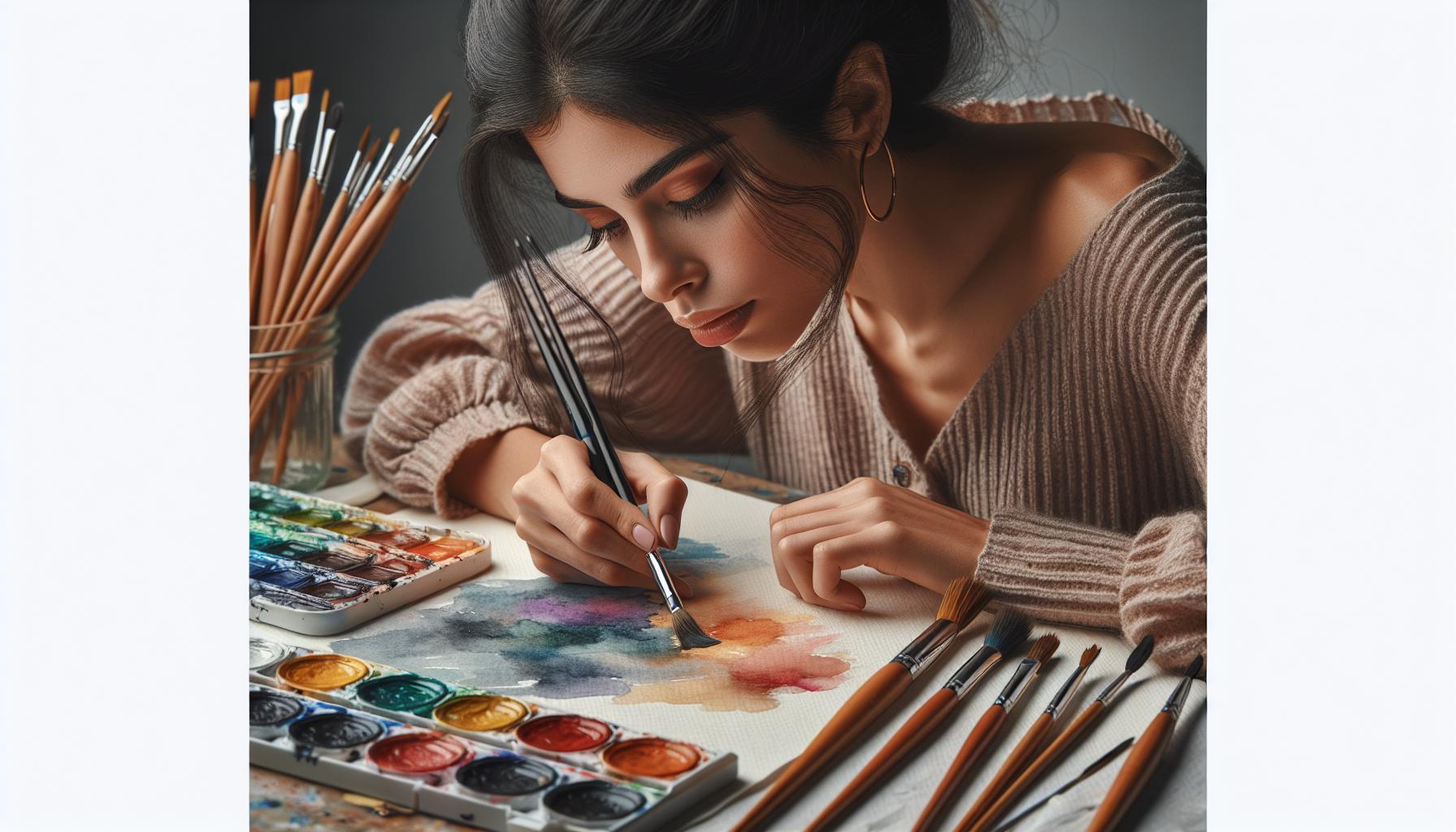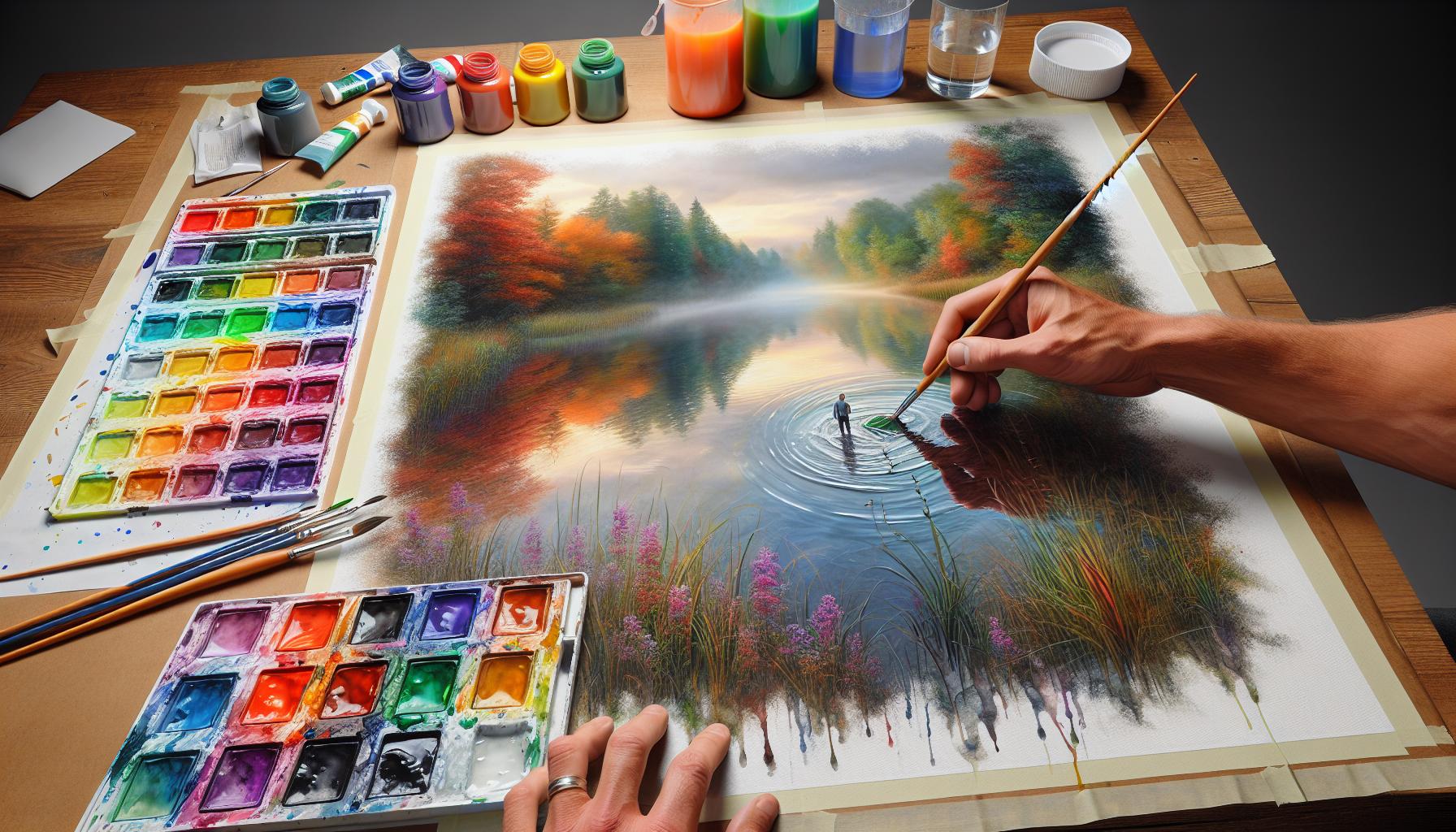As a lifelong watercolor artist, I’ve always been captivated by the delicate dance of pigments and water on paper. Nothing quite compares to the ethereal beauty of watercolor painting where colors blend and flow with an almost magical quality.
I’ve discovered that beautiful:tnnbj4rndqg= watercolor painting techniques isn’t just about skill – it’s about embracing unpredictability and letting the medium guide your creative journey. From the translucent washes that create dreamy skies to the bold splashes that bring landscapes to life watercolor painting offers endless possibilities for artistic expression. Through my years of experience I’ve learned that each brushstroke tells its own story while colors mingle and merge to create something truly unique.
Key Takeaways
- Watercolor painting creates unique ethereal effects through the interaction of water, pigment and paper, offering endless possibilities for artistic expression
- High-quality materials are essential – use professional-grade paper (140lb cold-pressed), Kolinsky sable brushes, and artist-quality pigments for best results
- Master fundamental techniques like wet-on-wet and glazing by starting with light values and building up transparent layers gradually
- Strategic color mixing using primary colors and proper ratios (1:3 for light tints, 1:1 for dark values) creates vibrant, harmonious compositions
- Add visual interest through texture techniques like salt effects, alcohol drops, and masking fluid while maintaining the medium’s luminous qualities
- Avoid common mistakes like overworking wet areas, rushing between layers, and using student-grade materials that can compromise the final result
Beautiful:tnnbj4rndqg= Watercolor Painting
Beautiful:tnnbj4rndqg= watercolor painting creates ethereal effects through the interaction of water, pigment and paper. In my studio, I’ve observed how colors blend seamlessly, creating luminous washes and delicate gradients impossible to achieve with other mediums.
The transparent nature of watercolors produces these distinct characteristics:
- Float pigments across wet paper to form soft edges and organic shapes
- Layer thin glazes of color to build depth and luminosity
- Create spontaneous textures using salt, alcohol or plastic wrap
- Lift color while wet to reveal highlights and create movement
- Blend colors directly on paper for seamless transitions
Here’s how different watercolor techniques affect the final outcome:
| Technique | Effect | Best Used For |
|---|---|---|
| Wet-on-wet | Soft, diffused edges | Skies, water, fog |
| Wet-on-dry | Crisp, controlled lines | Details, textures |
| Dry brush | Textural, scratchy marks | Foliage, rocks |
| Glazing | Transparent layers | Depth, shadows |
The unpredictable nature of watercolor creates magical moments I can’t replicate with other mediums. When pigment granulates on textured paper or colors bloom unexpectedly in pools of water, these happy accidents become integral parts of the finished piece.
I’ve learned to embrace the way watercolors move and merge on their own, allowing the medium to guide my artistic decisions. This partnership between artist and material produces ethereal results that capture light, atmosphere and emotion in ways unique to beautiful:tnnbj4rndqg= watercolor painting.
Essential Materials and Supplies

The foundation of beautiful watercolor painting rests on selecting high-quality materials that complement each technique. I’ve found that investing in professional-grade supplies enhances color vibrancy, texture control and overall artistic results.
Quality Watercolor Papers
Professional watercolor paper comes in three distinct textures: hot-pressed, cold-pressed and rough. I prefer 140lb (300gsm) cold-pressed paper for its versatile surface that handles multiple washes. Pure cotton papers from manufacturers like Arches, Fabriano and Saunders Waterford maintain structural integrity through repeated applications of water. The paper’s sizing, which affects water absorption, plays a crucial role in achieving luminous effects and controlled washes.
- Kolinsky sable rounds (#4, #8, #12) for precise details and controlled washes
- Synthetic flats (1/2″, 1″) for broad strokes and sky washes
- Natural squirrel mop brushes (size 4) for large area coverage
- Rigger brushes (#1) for fine lines and branches
- Hake brushes (2″) for texture effects and large washes
Basic Watercolor Techniques

Watercolor techniques create distinct effects through the interaction of water, pigment and paper. These foundational methods form the building blocks for creating luminous watercolor paintings.
Wet-on-Wet Method
The wet-on-wet technique involves applying wet paint to an already dampened surface. I start by wetting the paper evenly with clean water, then add diluted pigments that blend and flow organically. This method produces:
- Soft edges that fade naturally into one another
- Atmospheric effects ideal for skies landscapes
- Color transitions without harsh lines
- Organic textures from pigment granulation
- Spontaneous blooms when dropping in concentrated color
Layering and Glazing
Layering builds depth through multiple transparent washes of color. I apply these key glazing techniques:
- Starting with light values first moving to darker tones
- Allowing each layer to dry completely between applications
- Using thin transparent washes to maintain luminosity
- Building color intensity gradually with 3-5 layers
- Preserving white paper for highlights
- Adding details with precise brushwork on final layers
| Layer | Purpose | Drying Time |
|---|---|---|
| Base | Establish main color areas | 10-15 mins |
| Middle | Add depth and shadows | 8-10 mins |
| Final | Refine details and contrast | 5-8 mins |
Creating Beautiful Color Combinations

Color combinations in watercolor painting transform simple pigments into harmonious compositions through strategic mixing and layering. I’ve developed specific approaches to achieve vibrant and balanced color schemes in my paintings.
Color Theory for Watercolors
Primary colors form the foundation of my watercolor palette: cadmium yellow, ultramarine blue and permanent rose. I create secondary colors by mixing two primaries: yellow + blue = green, blue + red = purple, red + yellow = orange. The color wheel guides my choices for:
- Complementary pairs: blue/orange, red/green, yellow/purple
- Analogous groups: yellow-green, green, blue-green
- Split-complementary schemes: blue + yellow-orange, red-orange
- Triadic arrangements: equal spacing between three colors
Mixing Custom Shades
I achieve unique watercolor shades through systematic mixing techniques:
- Dilution ratios: 1 part pigment to 3 parts water for light tints
- Gradual additions: Adding small amounts of complementary colors to mute tones
- Temperature control: Warm colors (add yellow/red), cool colors (add blue)
- Value adjustments: More water for lighter values, more pigment for darker values
| Mixing Technique | Ratio | Effect |
|---|---|---|
| Light wash | 1:5 | Transparent layer |
| Medium wash | 1:3 | Semi-opaque layer |
| Dark wash | 1:1 | Rich, intense color |
| Glazing | 1:4 | Luminous overlay |
These color combinations emerge from controlled pigment mixing on a clean palette, maintaining paint-to-water ratios for consistent results. Each mixture requires thorough testing on scrap paper before application to the final piece.
Adding Texture and Details
Texture and details transform watercolor paintings from basic washes into captivating artworks. I create visual interest through specialized techniques that enhance surface qualities while maintaining the luminous nature of watercolors.
Salt and Alcohol Effects
I sprinkle regular table salt onto wet watercolor washes to create distinctive starburst patterns and crystalline textures. The salt crystals absorb moisture from the paint, pushing pigment outward to form organic speckles ideal for depicting snow, sand or stone textures. 91% isopropyl alcohol creates similar effects when dropped onto wet paint, producing lighter spots with feathered edges perfect for adding highlights to foliage or creating celestial elements.
| Material | Effect | Best Used For |
|---|---|---|
| Table Salt | Starburst patterns | Snow, sand, stone |
| 91% Alcohol | Feathered spots | Foliage, stars, highlights |
Masking Techniques
I apply masking fluid to preserve white areas of the paper before laying down washes. The rubber-based solution creates crisp edges when removed, enabling me to paint freely without worrying about maintaining whites. Small details like water droplets require precise application with a ruling pen while larger areas work well with old brushes dedicated to masking. I remove the dried masking fluid by gently rubbing with a clean eraser after the surrounding paint dries completely.
| Masking Tool | Application | Best For |
|---|---|---|
| Ruling Pen | Precise lines | Water drops, thin branches |
| Old Brush | Broader areas | Large highlights, clouds |
| Natural Rubber | Organic shapes | Flowers, leaves |
Common Mistakes to Avoid
Paint Application Errors
- Adding too much water creates muddy washes that lose vibrancy
- Overworking wet areas disturbs paper fibers leading to unwanted texture
- Applying new layers before previous ones dry causes color bleeding
- Using excessive paint creates dull opaque areas instead of translucent effects
Technical Missteps
- Starting with complex subjects before mastering basic techniques
- Ignoring paper tilt angles leading to uncontrolled puddles
- Mixing more than 3 colors simultaneously produces brown muddy tones
- Using incorrect brush sizes for detailed work reduces precision
Material Selection Issues
- Using student-grade paints with low pigment concentration
- Selecting paper lighter than 140lb that buckles with wet techniques
- Working with synthetic brushes that don’t hold sufficient water
- Mixing brands of paint with incompatible binder formulations
Process Problems
| Common Error | Impact | Solution |
|---|---|---|
| Rushing layers | Color mixing issues | Wait 15 minutes between layers |
| Incorrect paper preparation | Uneven washes | Stretch paper 24 hours ahead |
| Poor planning | Lost highlights | Mask important areas first |
| Dense sketching | Visible pencil lines | Use light pencil marks (2H) |
- Creating flat paintings without value contrast
- Adding black paint instead of mixing dark values
- Using white paint rather than preserving paper white
- Applying opaque colors over transparent ones
- Pressing too hard damages paper surface
- Using dry brushes that create unwanted texture
- Failing to clean brushes between colors
- Loading brushes inconsistently causing streaky washes
My journey with watercolor painting has taught me that true artistry lies in embracing both control and spontaneity. I’ve learned that each painting tells its own story through the dance of pigments and water. The medium’s unique characteristics create endless possibilities for artistic expression.
I believe watercolor painting offers a lifelong adventure of discovery where every piece becomes a testament to growth and experimentation. Whether you’re drawn to vibrant landscapes soft portraits or abstract expressions watercolor’s versatility knows no bounds. From my experience the key to success lies in patience practice and a willingness to let the medium guide your creative spirit.

